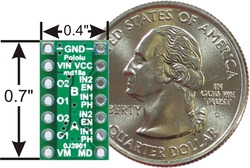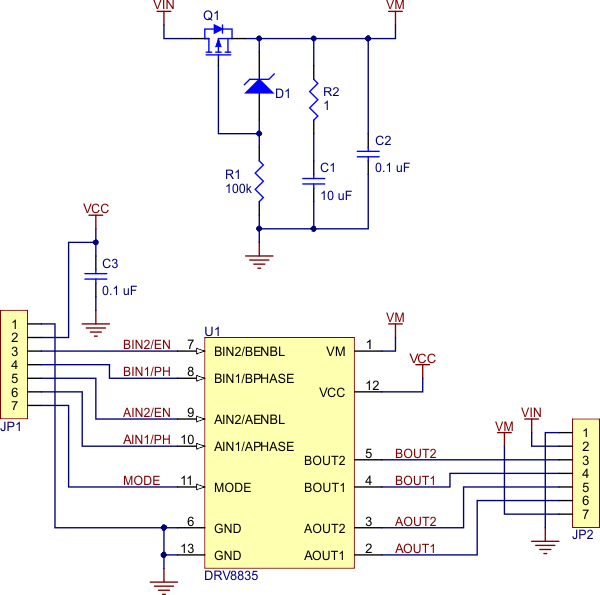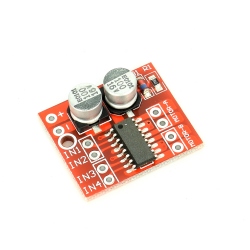Dupa plasarea solicitării de comandă, in sectiunea Istoric puteti vedea cate solicitări de comandă mai avem de procesat inaintea dumneavoastra
Program de lucru: Luni - Vineri 9:00 - 18:00, pauza 13:00 - 14:00.
Se efectueaza lucrari de mentenanta la site si pot aparea erori. In cazul in care intampinati erori va rugam sa reincercati mai tarziu.
Ridicarea personala este disponibila pentru comenzile achitate in avans. Se pot ridica dupa ce sunt pregatite.
No products
 View larger
View larger
Dual Pololu DRV8835 Engine Driver
0104110000029263
New product
This tiny breakout board for TI’s DRV8835 dual motor driver can deliver 1.2 A per channel continuously (1.5 A peak) to a pair of DC motors, and it supports two possible control interfaces for added flexibility of use: IN/IN and PHASE/ENABLE. With an operating voltage range from 0 V to 11 V and built-in protection against reverse-voltage, under-voltage, over-current, and over-temperature, this driver is a great solution for powering up to two small, low-voltage motors. The carrier board has the form factor of a 14-pin DIP package, which makes it easy to use with standard solderless breadboards and 0.1" perfboards.
See description for more details about the product.
Add to cart now!
This product is no longer in stock
- Write a review
- Remove this product from my favorite's list.
- Add this product to my list of favorites.
More info
Overview
Texas Instruments’ DRV8835 is a tiny dual H-bridge motor driver IC that can be used for bidirectional control of two brushed DC motors at 0 V to 11 V. It can supply up to about 1.2 A per channel continuously and can tolerate peak currents up to 1.5 A per channel for a few seconds, making it an ideal driver for small motors that run on relatively low voltages. The DRV8835 is a great IC, but its small, leadless package makes it difficult for the typical student or hobbyist to use; our breakout board gives this driver the form factor of a 14-pin DIP package, which makes it easy to use with standard solderless breadboards and 0.1" perfboards. Since this board is a carrier for the DRV8835, we recommend careful reading of the DRV8835 datasheet.

DRV8835 dual motor driver carrier, bottom view with dimensions
Alternative driver options
This board is very similar to our DRV8833 dual motor driver carrier in operating voltage range and continuous current rating, but the DRV8835 has a lower minimum operating voltage, offers an extra control interface mode, and is 0.1" smaller in each dimension. The DRV8833 has a higher peak current rating (2 A per channel vs 1.5 A), optional built-in current-limiting, and no need for externally supplied logic voltage.
For a smaller, lower-cost, single-channel alternative to this driver, please consider our DRV8838 carrier. The DRV8838 has the same operating voltage range as the DRV8835 and very similar current capabilities, and it uses the same PHASE/ENABLE control interface.
For higher-voltage alternatives to this driver, consider our A4990 and DRV8801 motor driver carriers.
We also carry a DRV8835 dual motor driver Arduino shield that makes it easy to incorporate this great driver into an Arduino project, as well as a DRV8835 motor driver kit for the Raspberry Pi.

TI SN754410 (16-pin DIP) next to the #2135 DRV8835 carrier (14-pin DIP) and #2990 DRV8838 carrier (10-pin DIP) for size reference.
Features
• Dual-H-bridge motor driver: can drive two DC motors or one bipolar stepper motor
• Motor supply voltage: 0 V to 11 V
• Logic supply voltage: 2 V to 7 V
• Output current: 1.2 A continuous (1.5 A peak) per motor
• Motor outputs can be paralleled to deliver 2.4 A continuous (3 A peak) to a single motor
• Two possible interface modes: IN/IN (outputs mostly mirror inputs) or PHASE/ENABLE (one pin for direction and another for speed)
• Inputs are 3V- and 5V-compatible
• Under-voltage lockout on the logic supply and protection against over-current and over-temperature
• Reverse-voltage protection on the motor supply
• Compact size (0.7"x 0.4") with the form factor of a 14-pin DIP package
Using the motor driver

Minimal wiring diagram for connecting a microcontroller to a DRV8835 dual motor driver carrier in phase-enable mode.
Motor and motor power connections are made on one side of the board and logic power and control connections are made on the other. The driver requires a motor voltage between 0 V and 11 V to be supplied to the VIN or VMM pin and a logic voltage between 1.8 V and 7 V to be supplied to the VCC pin; the logic voltage can typically be supplied by or shared with the controlling device. The VIN pin is the reverse-protected motor supply input and is the recommended point for connecting motor power. However, driver performance will start getting worse when the input voltage to the reverse-protection circuit is below a few volts, and 1.5 V is the lower limit of where the VIN pin can be used. For very low voltage applications, the motor supply should be connected directly to VMM, which bypasses the reverse-protection circuit.
The DRV8835 features two possible control modes: IN/IN and PHASE/ENABLE. The MODE pin determines the control interface. Each control input is pulled low through a weak pull-down resistor (approximately 100 kΩ), so the driver will be in the IN/IN mode if the MODE pin is left disconnected, and the driver outputs will be disabled by default. Setting the MODE pin high, either with a pull-up resistor or a driving-high I/O line, sets the driver to PHASE/ENABLE mode, where the PHASE pin determines the motor direction and the ENABLE pin can be supplied with a PWM signal to control the motor speed. This mode is generally easier to use as it only requires one PWM per channel, but it only allows for drive/brake operation. (Drive/brake operation usually provides a more linear relationship between PWM duty cycle and motor speed than drive/coast operation, and we generally recommend using drive/brake operation when possible.)
| Simplified drive/brake operation with MODE=1 (PHASE/ENABLE) | ||||
| xPHASE | xENABLE | xOUT1 | xOUT2 | operating mode |
| 0 | PWM | PWM | L | forward/brake at speed PWM % |
| 1 | PWM | L | PWM | reverse/brake at speed PWM % |
| X | 0 | L | L | brake low (outputs shorted to ground) |
Advanced usage with IN/IN mode

Minimal wiring diagram for connecting a microcontroller to a DRV8835 dual motor driver carrier in in-in mode.
When the MODE pin is disconnected or low, the control interface is IN/IN, which allows for slightly more advanced control options. The following truth table show how to achieve drive/coast and drive/brake operation using the IN/IN control interface:
| Drive/coast or drive/brake operation with MODE=0 (IN/IN) | ||||
| xIN1 | xIN2 | xOUT1 | xOUT2 | operating mode |
| 0 | 0 | OPEN | OPEN | coast (outputs off) |
| PWM | 0 | PWM | L | forward/coast at speed PWM % |
| 0 | PWM | L | PWM | reverse/coast at speed PWM % |
| 1 | PWM | PWM | L | forward/brake at speed 100% - PWM % |
| PWM | 1 | L | PWM | reverse/brake at speed 100% - PWM % |
| 1 | 1 | L | L | brake low (outputs shorted to ground) |
Pinout


Real-world power dissipation considerations
The DRV8835 datasheet recommends a maximum continuous current of 1.5 A per motor channel. However, the chip by itself will overheat at lower currents. For example, in our tests at room temperature with no forced air flow, the chip was able to deliver 1.5 A per channel for approximately 15 seconds before the chip’s thermal protection kicked in and disabled the motor outputs, while a continuous current of 1.2 A per channel was sustainable for many minutes without triggering a thermal shutdown.
Note that when both the logic and motor supply voltages are low (on order of a few volts), the driver will start overheating sooner and the maximum achievable output current will be lower than what we observed in the tests mentioned above.
The actual current you can deliver will depend on how well you can keep the motor driver cool. The carrier’s printed circuit board is designed to draw heat out of the motor driver chip, but performance can be improved by adding a heat sink. Our tests were conducted at 100% duty cycle; PWMing the motor will introduce additional heating proportional to the frequency.
This product can get hot enough to burn you long before the chip overheats. Take care when handling this product and other components connected to it.
Schematic

Schematic of the DRV8835 dual motor driver carrier
Specifications

Notes:
- Without included hardware.
- Typical results with VIN=5 V, VCC=5 V, and 100% duty cycle at room temperature.
Resources
Recommended links
Texas Instruments DRV8835 product page
Texas Instruments product page for the DRV8835, where you can find the latest datasheet and additional resources.
Don't delay, buy today.
Add to cart now!
Reviews
Customers who bought this product also bought:
-

Miniature...
Dual Miniature Engine Driver Module is perfect...
$0.90
-

TCS230 Color...
The TCS230 color sensor module is ideal for...
$9.36
-

30 cm 10p...
Ideal wires for making connections for...
$1.39
-

DRV8833...
DRV8833 Motor Driver Module See description...
$4.80
-

NFC NTAG203...
This product is a very small NFC NTAG203...
$0.62
-

M3 Washer
The high-quality assortment washers are perfect...
$0.05
-

4 x 18650...
This battery case can hold 4 x 18650 3.7 V...
$1.20
-

Cynel Solder...
Cynel Solder 100 g 1 mm
$10.71
-

30 cm 10p...
30 cm 10p Male-Male Wires See description for...
$1.20
-

2 x 10p...
Double Row 2.54 mm Pitch Height of Plastic: 8.5...
$0.79









